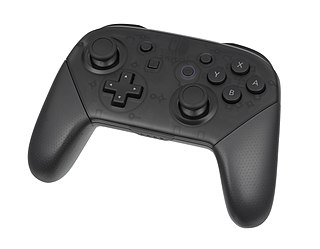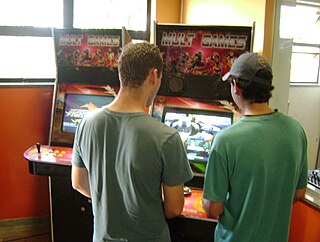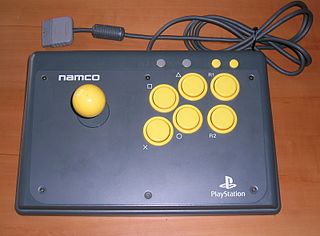Related Research Articles

The Atari 5200 SuperSystem or simply Atari 5200 is a home video game console introduced in 1982 by Atari, Inc. as a higher-end complement for the popular Atari Video Computer System. The VCS was renamed to the Atari 2600 at the time of the 5200's launch. Created to compete with Mattel's Intellivision, the 5200 wound up a direct competitor of ColecoVision shortly after its release. While the Coleco system shipped with the first home version of Nintendo's Donkey Kong, the 5200 included the 1978 arcade game Super Breakout which had already appeared on the Atari 8-bit family and Atari VCS in 1979 and 1981 respectively.

The Neo Geo, stylized as NEO•GEO and also written as NEOGEO, is a ROM cartridge-based arcade system board and fourth generation home video game console released on April 26, 1990, by Japanese game company SNK Corporation. It was the first system in SNK's Neo Geo family.

Microsoft SideWinder was the general name given to the family of digital game controllers developed by Microsoft for PCs. The line was first launched in 1995. Although intended only for use with Microsoft Windows, Microsoft SideWinder game controllers can also be used with macOS, Mac OS 9 with third-party software, and Linux.

A gamepad is a type of video game controller held in two hands, where the fingers are used to provide input. They are typically the main input device for video game consoles.

An arcade cabinet, also known as an arcade machine or a coin-op cabinet or coin-op machine, is the housing within which an arcade game's electronic hardware resides. Most cabinets designed since the mid-1980s conform to the Japanese Amusement Machine Manufacturers Association (JAMMA) wiring standard. Some include additional connectors for features not included in the standard.

QEMU is a free and open-source emulator. It emulates a computer's processor through dynamic binary translation and provides a set of different hardware and device models for the machine, enabling it to run a variety of guest operating systems. It can interoperate with Kernel-based Virtual Machine (KVM) to run virtual machines at near-native speed. QEMU can also do emulation for user-level processes, allowing applications compiled for one architecture to run on another.

An arcade controller is a collective set of input devices designed primarily for use in an arcade cabinet. A typical control set consists of a joystick and a number of push-buttons. Less common setups include devices such as trackballs or steering wheels. These devices are generally produced under the assumption that they will be used in commercial settings, such as in video arcades, where they may be heavily or roughly used. Durability is one of the distinguishing characteristics of "authentic" arcade parts when compared with numerous, low-cost arcade imitations designed for private use in the home.
Time Traveler or Hologram Time Traveler is a LaserDisc interactive movie arcade game. It was designed by Dragon's Lair creator Rick Dyer, and released in 1991 by Sega. Its plot is that an American old west cowboy named Marshal Gram travels to various timelines to rescue Princess Kyi-La and defeat the evil time lord Vulcor. The game is best known for its arcade cabinet which displays a "holographic" like projection, produced using optical technology from Dentsu.

Intellivision Lives! is a compilation of over 60 Intellivision video games, originally produced by Mattel Electronics and INTV Corporation between 1978 and 1990. Using original game code and software emulation, Intellivision Productions released the compilation on a Windows and Macintosh hybrid CD-ROM in December 1998. Additional versions were then released for the PlayStation 2, Xbox, and GameCube by Crave Entertainment. In 2010, Virtual Play Games released a Nintendo DS version.
A video game accessory is a distinct piece of hardware that is required to use a video game console, or one that enriches the video game's play experience. Essentially, video game accessories are everything except the console itself, such as controllers, memory, power adapters (AC), and audio/visual cables. Most video game consoles come with the accessories required to play games out of the box : one A/V cable, one AC cable, and a controller. Memory is usually the most required accessory outside of these, as game data cannot be saved to compact discs. The companies that manufacture video game consoles also make these accessories for replacement purposes as well as improving the overall experience. There is an entire industry of companies that create accessories for consoles as well, called third-party companies. The prices are often lower than those made by the maker of the console (first-party). This is usually achieved by avoiding licensing or using cheaper materials. For the mobile systems like the PlayStation Portable and Game Boy iterations, there are many accessories to make them more usable in mobile environments, such as mobile chargers, lighting to improve visibility, and cases to both protect and help organize the collection of system peripherals to. Newer accessories include many home-made things like mod chips to bypass manufacturing protection or homemade software.

Neo Geo is a family of video game hardware that was developed by SNK. On the market from 1990 to 2004, the brand originated with the release of an arcade system, the Neo Geo Multi Video System (MVS) and its home console counterpart, the Neo Geo Advanced Entertainment System (AES).
Various accessories for the PlayStation 3 video game console have been produced by Sony and third-party companies. These include controllers, audio and video input devices like microphones, video cameras, and cables for better sound and picture quality.

The Namco Arcade Stick is an arcade controller released by Namco in 1996 for the PlayStation.

A video game console emulator is a type of emulator that allows a computing device to emulate a video game console's hardware and play its games on the emulating platform. More often than not, emulators carry additional features that surpass limitations of the original hardware, such as broader controller compatibility, timescale control, easier access to memory modifications, and unlocking of gameplay features. Emulators are also a useful tool in the development process of homebrew demos and the creation of new games for older, discontinued, or rare consoles.

The Neo Geo X (NGX) is a hybrid video game console manufactured by Tommo, licensed by SNK Playmore. Information about the Neo Geo X was first reported in January 2012 and later confirmed in March. It is the first Neo Geo system to be released since the discontinuation of the brand in 2004 and the third Neo Geo handheld console, following the 1999 release of the Neo Geo Pocket Color, which was supported until 2001.
Rhythm game accessories are often required to play rhythm games available for various consoles, such as the PlayStation 2, PlayStation 3, Wii, and Xbox 360. These include dance pads, guitar controllers, drum controllers, microphones and turntable controllers. With the exception of microphones, these controllers can generally be used to control any game, but have limited inputs, making them impractical for most games.

The Xbox Wireless Controller is the primary game controller for the Xbox One and Xbox Series X/S home video game consoles, also the official controller for use in Windows-based PCs, and compatible with other operating systems such as macOS, Linux, iOS, and Android. The controller maintains the overall layout found in the Xbox 360 controller, but with various tweaks to its design, such as a revised shape, redesigned analog sticks, shoulder buttons, and triggers, along with new rumble motors within the triggers to allow for directional haptic feedback.

The Atari VCS is a home video game console produced by Atari, Inc. While its physical design is intended to pay homage to the Atari 2600, the new Atari VCS plays modern games and streaming entertainment via a Linux-based operating system called AtariOS that will allow users to download and install other compatible games, including those compatible with Windows 10. The system shares a name with Atari, Inc.'s 1977 Video Computer System, usually shortened to VCS, which was renamed to the Atari 2600 in late 1982.
References
- ↑ Greenwald, Will (December 11, 2013). "Xgaming X-Arcade Solo Joystick". PCMag.com. Ziff Davis.
- ↑ Dunham, Jeremy (October 14, 2002). "X-Arcade Review". IGN.